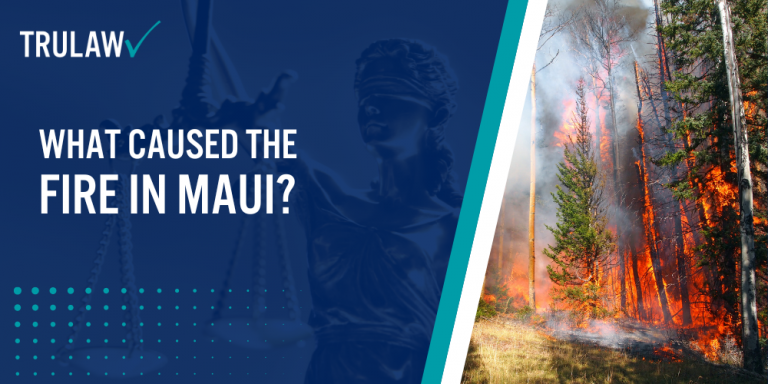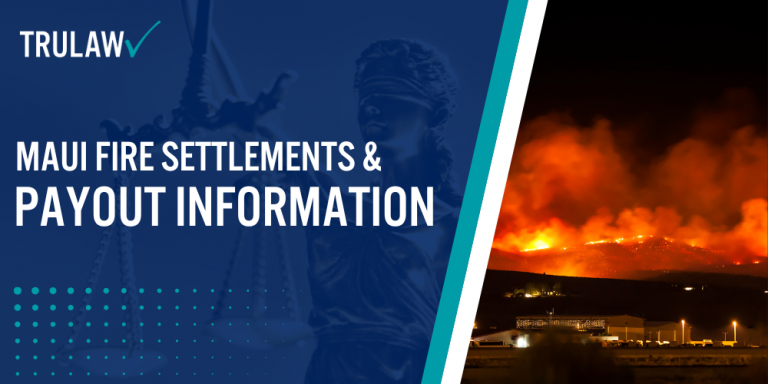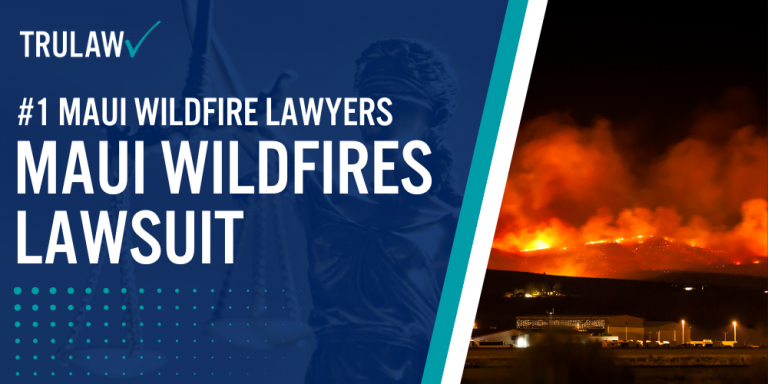FAQ: How Many People Died in The Maui Fires of 2023?
- Last Updated: July 9th, 2024

Attorney Jessie Paluch, founder of TruLaw, has over 25 years of experience as a personal injury and mass tort attorney, and previously worked as an international tax attorney at Deloitte. Jessie collaborates with attorneys nationwide — enabling her to share reliable, up-to-date legal information with our readers.
Legally Reviewed
This article has been written and reviewed for legal accuracy and clarity by the team of writers and legal experts at TruLaw and is as accurate as possible. This content should not be taken as legal advice from an attorney. If you would like to learn more about our owner and experienced injury lawyer, Jessie Paluch, you can do so here.
Fact-Checked
TruLaw does everything possible to make sure the information in this article is up to date and accurate. If you need specific legal advice about your case, contact us by using the chat on the bottom of this page. This article should not be taken as advice from an attorney.
Overview of the Deaths in the Maui Fires of 2023
Question: How many people died in the Maui fires of 2023?
Answer: The death toll from the Maui wildfires was initially reported to be 115 people.
However, after weeks of DNA review, the authorities have revised the number and currently believe that 97 people died in the Maui wildfire.
This revision was made possible by the meticulous work of anthropologists at the Department of Defense who conducted advanced genetic testing.
Their efforts ensured that victims were not mistakenly counted multiple times, especially in situations where multiple individuals might have been together, such as in a vehicle.
Intro to the Maui Fires of 2023
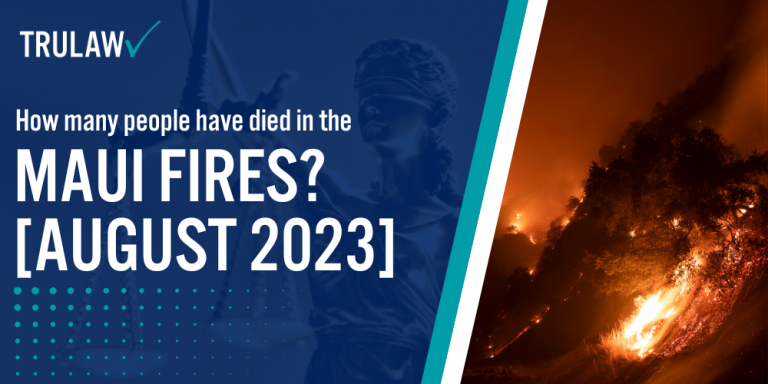
The Maui fires, which began on August 8th, almost completely destroyed the historic town of Lahaina.
The rapid spread of the flames forced many residents to seek refuge in the ocean to escape the encroaching blaze.
In the aftermath, rescue and recovery teams worked tirelessly, sifting through the remnants of homes, businesses, and historic landmarks, searching for any signs of life or remains.
As the community begins the process of healing and rebuilding, the state is making efforts to assist those affected.
Plans are in place to move over 7,400 displaced individuals from temporary hotel accommodations to long-term housing.
Additionally, the Environmental Protection Agency is actively involved in clearing hazardous materials from the affected areas in Maui.
Table of Contents
Background of the Maui Fires
The series of wildfires that besieged the Hawaiian island of Maui began a destructive path on August 8th.
The fires have burned substantial areas across the island, with over 2,000 acres in Lahaina, and hundreds of more acres in areas like Kula and Olinda.
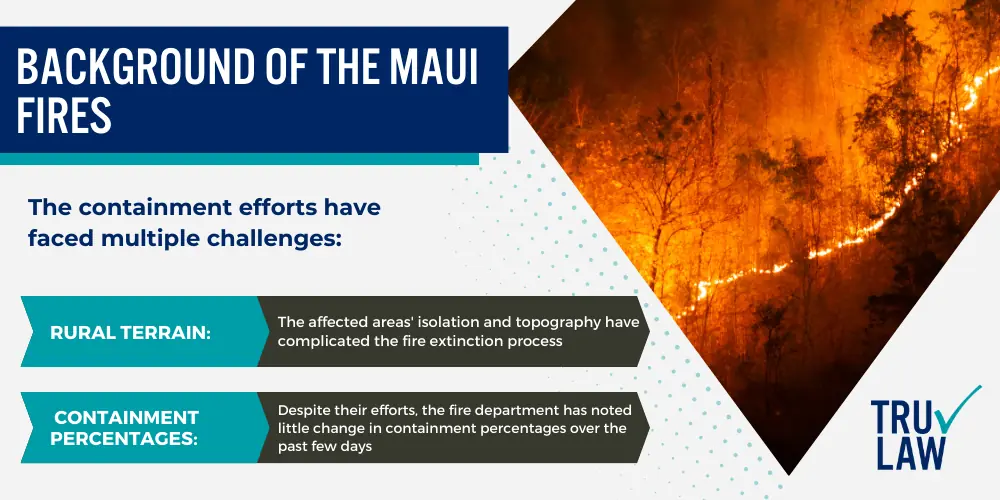
Location and Size of Maui Fires
The devastation was not confined to one area.
Major burns were reported in:
- Lahaina: The largest area affected, with over 2,000 acres of land consumed by the fire.
- Kula and Olinda: These two areas experienced hundreds of acres of damage, contributing to the expansive nature of this event.
Given the vast size of the burn area and the complex nature of the rural terrain, the Maui Fire Department (MFD) has indicated that extinguishing the fire may take an extended period of time.
Fire Management Challenges
The containment efforts have faced multiple challenges, including:
- Rural terrain: The affected areas’ isolation and topography have complicated the fire extinction process.
- Unchanging containment percentages: Despite their efforts, the fire department has noted little change in containment percentages over the past few days. This stagnation implies that the situation is regarding control and suppression remains severe.
Legal Consequences of the Maui Fires
In light of the significant damage incurred, a legal action was initiated to compensate for the destruction of the County’s public property and resources.
Notably, the Lahaina and Kula fires were at the center of this lawsuit.
Here are key points of the lawsuit:
- Court and case number: The lawsuit was filed in the Second Circuit Court, carrying the case number 2CCV-23-0000238.
- Aim of lawsuit: The goal of the legal action is to draw attention to and seek compensation for the extensive destruction that these wildfires have caused to public property and resources in the involved regions.
The background of the Maui fires shows a widespread devastation that has affected a significant portion of the island’s land.
The ongoing official efforts for extinguishment highlight the severity of the situation.
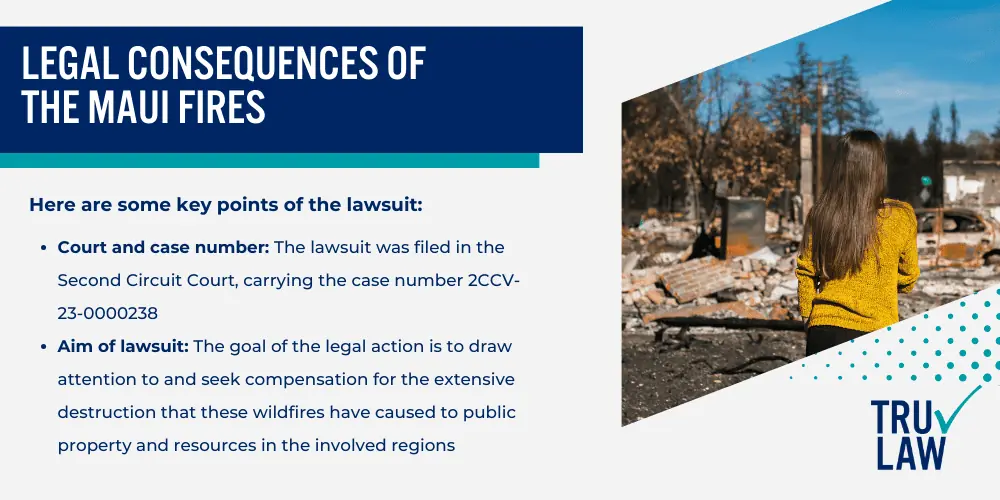
In addition, a legal battle has been initiated to address the extensive loss of public resources caused by these fires.
It is essential to remember that the effects of such a devastating event are far-reaching and long-lasting.
Apart from the obvious environmental impact, the societal and economic implications caused by the Maui fires are substantial.
This background paves the way for an in-depth analysis of the legal, environmental, and social aspects surrounding the Maui wildfires.
Fatalities of the Maui Fire
The Maui wildfires claimed a staggering death toll, ranking it as one of the deadliest natural disasters in the history of Hawaii and the United States overall.
The impact and devastation brought about by the blazes have been unparalleled, with over 97 confirmed fatalities.
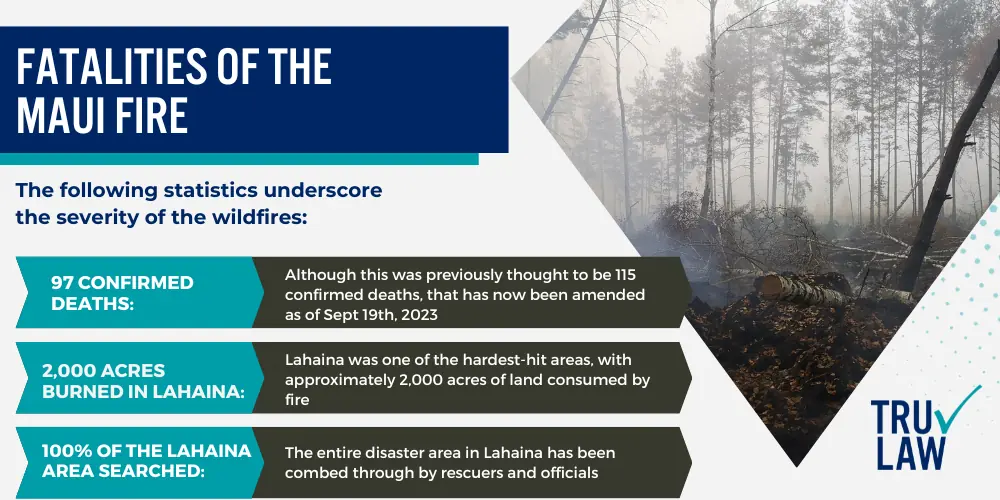
Notable Statistics
The following numbers underscore the severity of the wildfires:
- 97 Confirmed Deaths*: Although this was previously thought to be 115 confirmed deaths, that number has now been ammended as of September 19th, 2023. Even so, this still places the Maui wildfires amongst the highest death tolls in U.S. history due to a wildfire.
- 2,000 Acres Burned in Lahaina: Lahaina was one of the hardest-hit areas, with approximately 2,000 acres of land consumed by the fires. The extensive damage to this region significantly contributes to the high number of fatalities.
- 100% of the Lahaina Disaster Area Searched: The entirety of the disaster area in Lahaina has been combed through by rescuers and officials. Despite the massive scale of the area, search teams have made sure no stone was left unturned.
Comparative Analysis
The death toll from the Maui fires is substantial when compared to other U.S. wildfires in the last century:
- The 1918 fires in northeast Minnesota, previously considered the deadliest ever, resulted in numerous fatalities. However, the Maui wildfires have surpassed this grim figure.
- Recent data shows that U.S. wildfires typically claim less than 100 lives annually. The Maui fires’ 97 fatalities, therefore, represent a significant deviation from the norm.
The Humanitarian Impact
The human aspect of this catastrophic event cannot be understated.
The wildfires have devastated communities, displaced hundreds of people, and caused untold grief and trauma.
- Loss of Lives and Property: Beyond the 97 fatalities, numerous residents have been displaced from their homes. The loss of life and property has been severe, leaving entire families and communities mourning and rebuilding.
- Psychological Impact: The psychological consequences for survivors and families of victims can be incredibly distressing. Many individuals will likely require mental health support in the aftermath of such an event.
- Long-term Implications: The long-term effects of losing so many lives within a community are significant. The need for ongoing support, both emotional and material, will be required for years to come.
In conclusion, the Maui wildfires’ death toll underscores the immense devastation and far-reaching effects of this event.
With the highest number of fatalities in a century due to a wildfire, the impact of this disaster on the communities involved will be long-lasting.
This tragic event highlights the urgent need for effective wildfire prevention and response strategies to avert such heartbreaking losses in the future.
Maui Fires Impact on Communities
The devastating Maui wildfires have left an indelible mark on the communities in Lahaina and Kula, both environmentally and socio-economically.
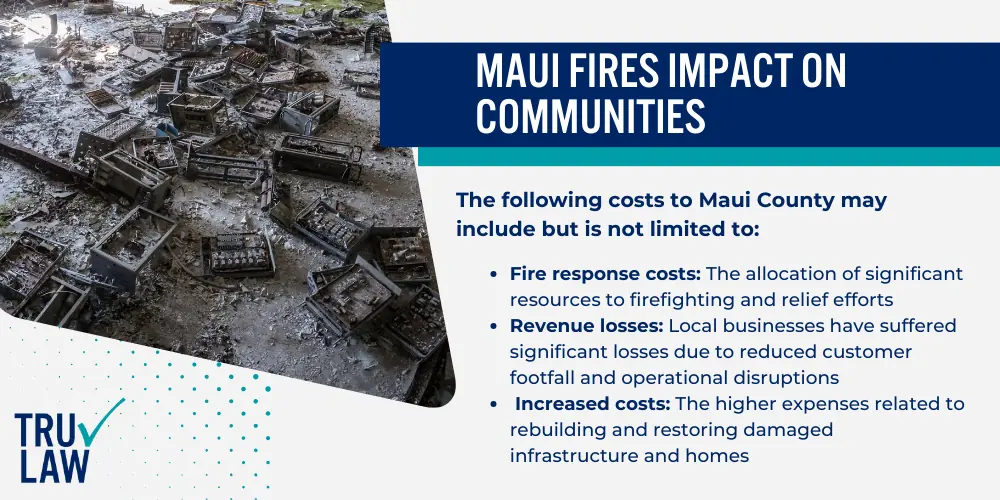
Infrastructure Damages
The fires have wreaked havoc on the public infrastructure in the affected areas.
Essential facilities such as roads, public buildings, utility lines, and water storage facilities have suffered extensive damages, which has resulted in several inconveniences for the local communities.
The following damages to Maui County’s infrastructure includes but is not limited to:
- Road closures and rerouting: This has resulted in longer travel times and greater fuel costs for residents and businesses.
- Disruption of utilities: Damaged power and water lines have caused intermittent supply outages, affecting daily living and business operations.
- Public building damage: The destruction of public buildings like community centers has disrupted various community activities.
Financial Impact
The wildfires have imposed a substantial financial burden on the affected communities.
The following costs to Maui County includes but is not limited to:
- Fire response costs: The allocation of significant resources to firefighting and relief efforts.
- Revenue losses: Local businesses have suffered significant losses due to reduced customer footfall and operational disruptions.
- Increased costs: The higher expenses related to rebuilding and restoring damaged infrastructure and homes.
Environmental Damages
Environmental damages caused by the wildfires have far-reaching implications on the community’s way of life, such as:
- Habitat loss: The fires have destroyed large swathes of natural habitats, threatening local flora and fauna.
- Air and water pollution: The smoke and ash from the fires have polluted the air and water sources, affecting health and agriculture.
- Soil erosion: The loss of vegetation due to the fires has led to increased soil erosion, affecting local farming and increasing the risk of landslides.
Loss of Historical and Cultural Landmarks
Cultural heritage forms an integral part of a community’s identity.
Unfortunately, the Maui wildfires have resulted in:
- Destruction of landmarks: Several historical and cultural landmarks have been lost to the flames, erasing irreplaceable elements of the community’s history and identity.
- Impact on tourism: These landmarks often attract tourists, contributing to local economies. Their loss will likely impact future tourism revenue.
Maui Fires: Resilience and Recovery
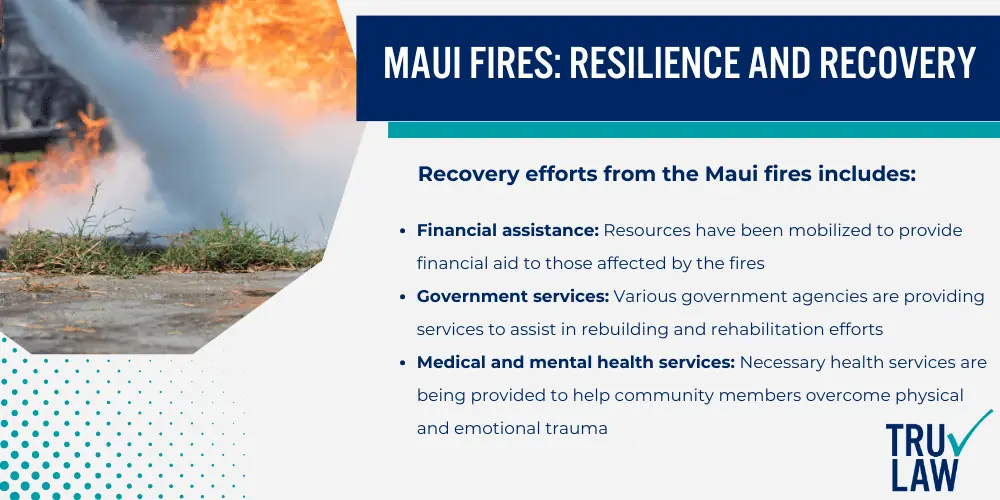
Despite the widespread destruction, the communities have shown tremendous resilience.
Through platforms like the Maui Nui Strong site, they have unified to support each other in this hour of need.
Recovery efforts include:
- Financial assistance: Resources have been mobilized to provide financial aid to those affected by the fires.
- Government services: Various government agencies are providing services to assist in rebuilding and rehabilitation efforts.
- Medical and mental health services: Necessary health services are being provided to help community members overcome physical and emotional trauma.
In conclusion, the Maui wildfires’ impact extends beyond mere physical damages.
The disaster has disrupted lives, livelihoods, and the very fabric of the community.
The indomitable spirit of the Maui communities, however, is a beacon of hope amidst these challenging times.
Preservation of Evidence in the Maui Fires
As one navigates through legal terrains, it becomes clear that evidence is the key cornerstone in building a strong case, as well as achieving justice.
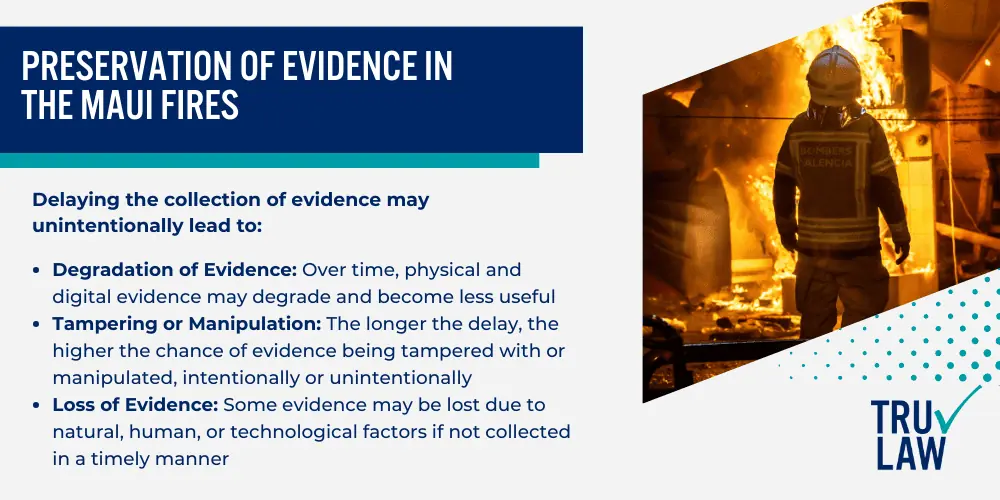
When it comes to company investigations, the proper handling and preservation of evidence around the scene can significantly impact the outcome of the legal proceedings.
Accordingly, this section will provide a detailed discussion on how the company should approach this crucial aspect, as per the guidelines stated in the previously mentioned paper.
The Importance of Timely Collection
Time plays a crucial role in the collection and preservation of evidence.
It is essential for any company to act as swiftly as possible after an incident has been identified.
Delaying the collection of evidence may unintentionally lead to:
- Degradation of Evidence: Over time, physical and digital evidence may degrade and become less useful.
- Tampering or Manipulation: The longer the delay, the higher the chance of evidence being tampered with or manipulated, intentionally or unintentionally.
- Loss of Evidence: Some evidence may be lost due to natural, human, or technological factors if not collected in a timely manner.
Online vs Offline Collection
In today’s digital age, evidence collection is not merely confined to the physical realm.
The company should be prepared to collect evidence both online and offline.
On the other hand, physical evidence can be submitted at local post offices during operational hours.
Evidence Handling Procedure
Lastly, it is vital that the evidence collection process be conducted systematically and in compliance with legal standards to ensure its validity in court.
To achieve this, follow the steps below:
- Identification: Clearly define what constitutes evidence in the context of the incident.
- Preservation: Safeguard the evidence from alteration, corruption, or loss.
- Collection: Gather the evidence while maintaining the integrity of its original state.
- Documentation: Record the collection process minutely. This should include details about when, where, and by whom the evidence was collected.
- Transfer: Pass the evidence to the designated person or team in a secure and controlled manner.
- Storage: Store the evidence in a secure location until it is required for legal proceedings.
Taking into account these considerations, it becomes clear how paramount the proper handling and preservation of evidence is to any legal proceedings.
An awareness and understanding of these principles not only strengthens the company’s legal position, but also demonstrates its commitment to the pursuit of justice, which can have far-reaching positive impacts on its brand image and reputation.
Frequently Asked Questions
-
When did the Maui Fires occur?
The Maui Fires occurred in August 2023, primarily on the island of Maui, Hawaii.
The fires started on the night of August 8th and rapidly grew in size and intensity due to dry conditions and high winds.
The fires resulted in widespread damage, with over 2,200 buildings destroyed and at least 97 people killed.
The total damage was estimated to be around $5.5 billion.
The fires led to mass evacuations and had a significant impact on the local community and wildlife.
The cause of the fires is still under investigation.
-
How many acres were affected by the Maui Fires?
The Maui Fires affected more than 2,500 acres across historic towns like Lahaina.
The Lahaina fire, which was the most devastating of the blazes, burned an estimated 2,170 acres.
Other fires in areas like Olinda and Kula also contributed to the total acreage affected
-
Were there any evacuations due to the Maui Fires?
Multiple fires in Maui have led to evacuations in Lahaina town, Kula, and Upcountry areas.
The fires have caused thousands of people to be displaced, and the death toll is currently at 97 fatalities (current as of September 19th, 2023).
The fires were fueled by dry winds from Hurricane Dora, but normal trade winds have been restored.
Evacuation shelters have been opened, and organizations across Hawaii are mobilizing to help fire victims.
Road closures, evacuation orders, and resources for evacuees have been provided.
The state is also looking to connect those who lost their homes with available housing units through a housing relief program.
-
How long did it take to contain the Maui Fires?
The wildfires in Maui have burned thousands of acres since they began earlier this month.
The most devastating fire in Lahaina burned an estimated 2,170 acres and is about 90% contained.
The Olinda fire in central Maui has burned an estimated 1,081 acres and is 85% contained, while the Kula fire has burned 202 acres and is 90% contained.
The Pulehu-Kihei fire has been fully contained.
The fires have destroyed or damaged at least 2,200 buildings, with an estimated cost to rebuild of $5.52 billion.
The fires have also led to an unsafe water advisory for Lahaina and Upper Kula.

Experienced Attorney & Legal SaaS CEO
With over 25 years of legal experience, Jessie is an Illinois lawyer, a CPA, and a mother of three. She spent the first decade of her career working as an international tax attorney at Deloitte.
In 2009, Jessie co-founded her own law firm with her husband – which has scaled to over 30 employees since its conception.
In 2016, Jessie founded TruLaw, which allows her to collaborate with attorneys and legal experts across the United States on a daily basis. This hypervaluable network of experts is what enables her to share reliable legal information with her readers!
You can learn more about the Maui Fire Lawsuit by visiting any of our pages listed below:
Here, at TruLaw, we’re committed to helping victims get the justice they deserve.
Alongside our partner law firms, we have successfully collected over $3 Billion in verdicts and settlements on behalf of injured individuals.
Would you like our help?
At TruLaw, we fiercely combat corporations that endanger individuals’ well-being. If you’ve suffered injuries and believe these well-funded entities should be held accountable, we’re here for you.
With TruLaw, you gain access to successful and seasoned lawyers who maximize your chances of success. Our lawyers invest in you—they do not receive a dime until your lawsuit reaches a successful resolution!
Do you believe you’re entitled to compensation?
Use our Instant Case Evaluator to find out in as little as 60 seconds!
Camp Lejeune’s water contamination issue spanned several decades starting in the 1950s. Exposure to these chemicals has been linked to various serious health issues, including cancer, organ diseases, and death.
Research is increasingly suggesting a link between the use of Tylenol during pregnancy and the development of neurodevelopmental disorders, such as autism and ADHD, in infants.
Legal action is being taken against manufacturers of Aqueous Film-Forming Foam (AFFF), a chemical used in fighting fires. The plaintiffs allege that exposure to the foam caused health issues such as cancer, organ damage, and birth and fertility issues.
Here, at TruLaw, we’re committed to helping victims get the justice they deserve.
Alongside our partner law firms, we have successfully collected over $3 Billion in verdicts and settlements on behalf of injured individuals.
Would you like our help?
